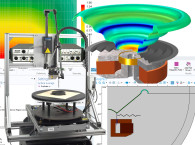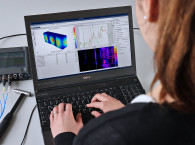All images courtesy of Mvoid Technologies GmbH
The big day has arrived: The prototype of the newly developed transducer is mounted into the loudspeaker cabinet for the first time. The loudspeaker is connected for a listening test. The test reveals unexpected rattling noises. Possibly an asymmetrical air load on the transducer causing a rocking mode or unwanted structural vibrations. This means that the product developers have to review the design for the next iteration step: They have to create a new model.
Running those tests during simulation stages could be extremely beneficial for everyone involved and even more if the results could be audible via headphones. Otherwise any modifications become expensive and time-consuming. Acoustical virtual development enables users to feed back the experience gained from the virtual listening test into the multiphysics simulation, make the necessary adjustments, and then use the newly calculated model for the next listening test, which can be shared between remote locations. Production and development costs can be saved as prototypes are designed, while products are improved at the same time.
The development of consumer and pro audio products is an increasingly complex and costly process. The faster incorrect approaches are rejected or modified, the faster a product reaches the market—and the lower the development costs. Acoustical virtual product development methods provide valuable help in optimizing the development of consumer and professional audio products while optimizing quality at the same time.
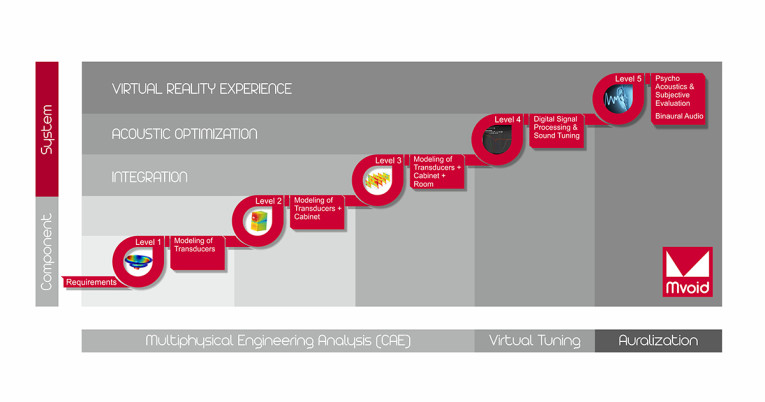
Acoustical Virtual Product Development
Despite the experience and long-established practices in the development of loudspeakers and audio systems, acoustic experts are always faced with new challenges. Unexpected noises and unbalanced sound reproduction must be analyzed, evaluated, and eliminated at an early stage. The earlier virtual methods are used in the product development process, the greater the advantages with regard to three essential objectives: quality, time, and cost.
Acoustical virtual product development methods enable designers to turn loudspeakers and audio systems into a realistic experience for the user — without the need for any physical object. The multidisciplinary simulation of a loudspeaker, as previously described, is only one possible application. Accessing the deepest corners of cabinets and even listening rooms, experts can analyze measurement points in the virtual domain, which are not accessible in the real world. This allows analysis and evaluation of undesired results that aren’t otherwise possible, leading to completely new development approaches. Various materials, changes in shape or a specific directional characteristic can be analyzed effortlessly in a short time without any prototype.
Every aspect of the system from sub-components through the cabinets, the ducts, the ports or the horns can be designed, auralized, and optimized. Multiple virtual prototypes can be modeled, assembled as systems, evaluated with virtual tuning and be validated in real acoustic venues through auralization.
Thanks to virtual mock-ups, decision-makers receive faster and better feedback from members of the development team, as the audible models provide a more realistic impression even for those at management level who are less familiar with design. The audible model of a new product makes it easier for team members to form opinions and it speeds up the decision-making process. Suggestions for improvement can be incorporated before even a single real model is produced. As a result, the number of iteration cycles during product development is reduced, while product quality is improved.
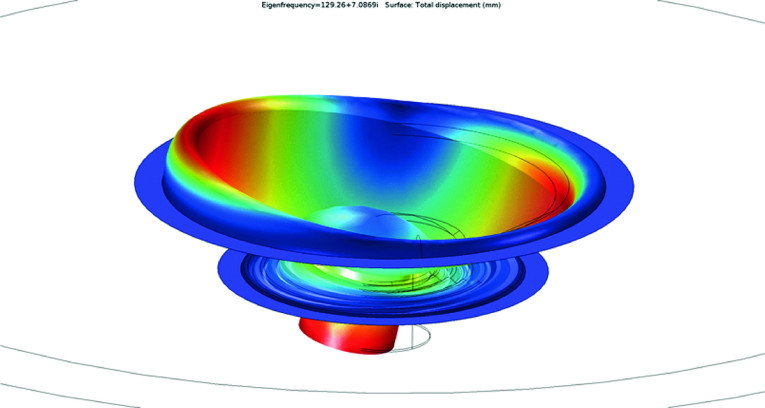
Many Factors Influence the Sound
In order to create a holistic virtual model, it is necessary to examine the complete system. In doing so, it is necessary to consider all involved subsystems and to investigate their reciprocal interaction as it will demonstrate their impact. In a listening situation, the overall system is significantly more than a loudspeaker—the loudspeaker, potentially in an array, room acoustics, and the perception of sound by humans.
To be able to listen to an audio system based on a virtual prototype, the following engineering disciplines need to be added to the analysis tools—digital signal processing, psychoacoustics, subjective evaluation, sound tuning, and auralization (binaural audio).
A step-by-step approach has proven successful, combining five different multidisciplinary levels. When all five levels are applied, a complete virtual product development environment is created, which allows a realistic listening experience of the virtual audio system at any time of the project. The methodology has been used for many years, especially in the automotive industry and is currently being adopted by pro and consumer R&D labs.

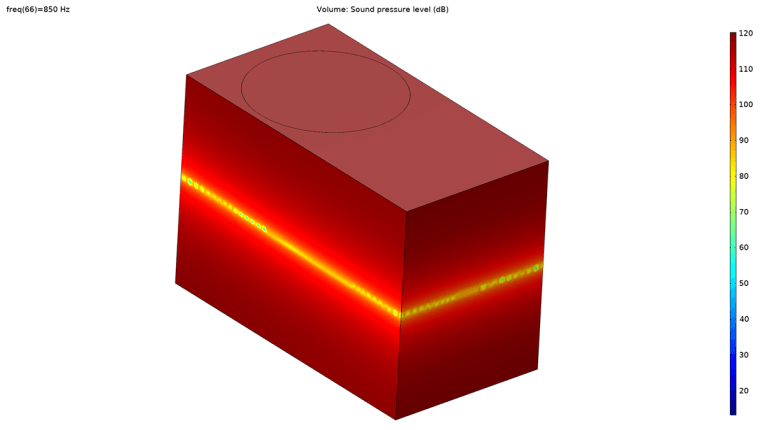
Multiphysical Simulation Modeling of Transducers
Within the first tier level, the goal is to create the multiphysical model of the transducer. The greatest challenge lies in analyzing the different physical domains, as each domain interacts bi-directionally with each other—electromagnetism (motor/drive system), structural dynamics (mechanical vibration system), acoustics (surrounding air), and sometimes also heat conduction and flow — since these are strongly coupled with each other. In addition, nonlinear effects that lead to disturbing distortions must be considered. With the support of multiphysical simulations, the acoustic experts are able to analyze interactions of all physical domains.
One dimension-lumped parameter models, 2D, 2.5D, and 3D finite element models are used for multiphysical simulation. Moreover, it is possible to generate small and large signal transducer reports that correlate to the physical samples.
Multiphysical Simulation Modeling of Transducers and Cabinets
Loudspeakers require an enclosure to produce a net volume flow at low frequencies. The enclosures and adjacent parts can create unintended noises. The interaction of the loudspeaker and the cabinet must be analyzed.
Practical problems are asymmetric air load on the transducer causing rocking mode, directivity of subwoofers, or structural vibrations. Multiphysical simulation allows examining structural dynamics and acoustics. Acoustics experts are able to quickly detect undesirable directivity effects, noises, or disturbances and find new solutions for enclosure design (e. g., alternative placement of components and alternative cabinet shapes).
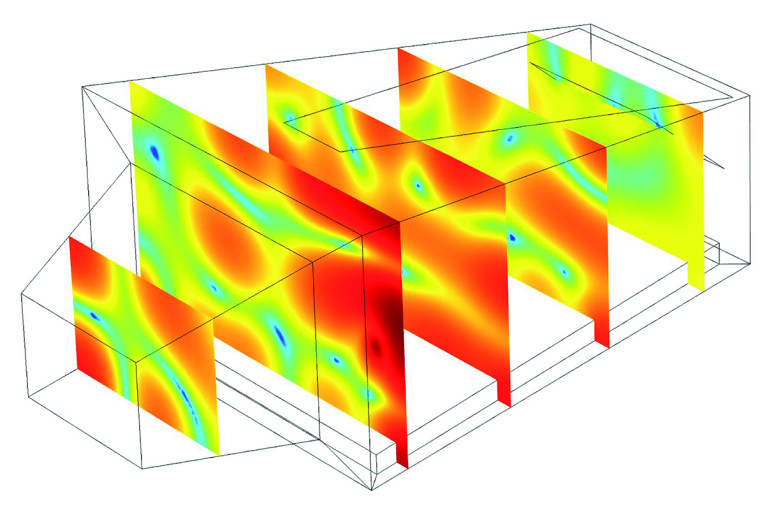
A Full-System Model
Multiphysical simulation models are able to determine distribution of sound and reflections in a room. The listening room has an important impact on the perception of the reproduced sound and acoustical comfort. There are many challenges to consider when designing for example a new line array system for touring, a concert hall, or theatre: the size of the hall, the shape of the ceiling, flat or curved walls, the position of the stage itself. All major factors that affect the sound in the interior must be taken into account.
Practical problems include the directivity pattern and placement of a loudspeaker for excitation of room modes or directivity of an array for sound coverage in a given space. Moreover, every space has a different transition band between these regimes:
• Low frequency: Modal range
• High frequency: Statistical area
• Transition range depends on the room size
By combining different simulation methods, the audible room acoustic effects can be analyzed. The 3D sound field is determined by physical mathematic parameters. Based on 3D CAD data, the interactions of loudspeakers and enclosures including the listening room are analyzed and evaluated in the multiphysical simulation model.
The simulation model allows visualization of all essential factors influencing the sound. The multiphysical simulation predicts the acoustics in a room. However, the multiphysical simulation does not predict the acoustic sound quality of a particular seat, on the basis of the calculated spectrum. This is possible in the next step.
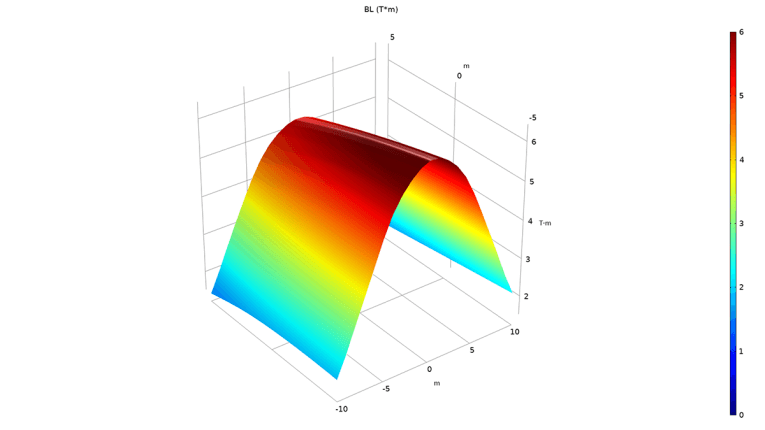
Better Sound Through Virtual Tuning
The human ear perceives all loudspeakers in a room as a group. In multiphysics simulation, the spatial attributes of human sound perception are not yet sufficiently taken into account. The analysis of the individual loudspeakers and their frequency behavior alone are not sufficient. In virtual tuning, the overall system is now evaluated on the basis of the simulation data.
Virtual tuning establishes the acoustic sound quality at a specific location. The interactions of the loudspeakers with each other are analyzed. There may be areas within the architecture of a room or venue in which sound waves cancel each other. In addition, irregularities or resonances can occur at certain positions. Certain frequencies may be too loud or too soft for an enjoyable listening experience. Typical problems are caused by resonances in a control room or unbalanced sound in an audience area.
The acoustics experts check whether there are any constructive or destructive influences. They examine whether the individual loudspeaker’s characteristics and placements can be influenced in such a way that their acoustic energy adds up optimally to create a sweet spot large enough for the entire audience.
At this stage, the acoustic experts put the complete virtual system through its paces. They predict reliably whether cost-intensive hardware changes will be necessary, such as the replacement of loudspeaker components or an integration adjustment. Or whether the desired sound reproduction is cost-effectively achievable — by means of tuning. To determine the perfect sound experience, they are able to analyze any specific location in the room, and adjust speaker characteristics for the best possible sound in each specific location.
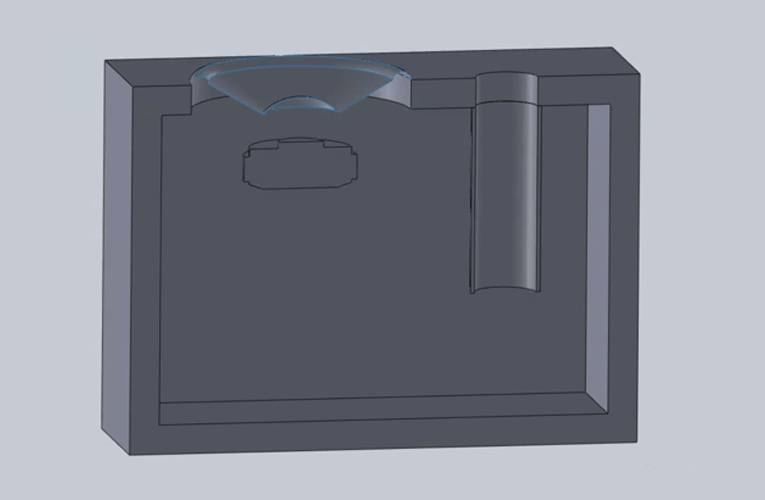
Acoustical Virtual Reality by Auralization
Virtual tuning is supported by auralization — the process of rendering an acoustic situation to make it audible. Auditory perception relies on the physiognomy such as ear shapes, head circumference, and body volume, which differs from person to person—it is not universal. The physical properties of sound arriving at the ears is transformed into a perception by the auditory system. Our ears transform sound waves into electrochemical impulses, which are transmitted from the nervous system to the brain where further processing and evaluation of the signal takes place.
For a realistic virtual listening experience, all important psychoacoustic effects are considered. This includes the detection and localization of incoming sound waves on the left and right ear. The incoming waves to our two ears are diffracted and reflected in different ways due to our anatomy (head, neck, shoulders, and ears) producing two signals that our brain processes into spatial information.
The auralization process makes it possible to hear digital prototypes of audio systems in a specific room, which might exist only on the drawing board, and to assess their product quality. The resulting soundfield is made audible through headphones, allowing acoustics experts to examine the interactions of audio products within a listening environment, evaluating important psychoacoustic effects of their spatial impressions.
To achieve realistic reproduction, calculations are extended with binaural data. The virtual listening environment uses a multiphysics model of the room impulse response as the starting point, determined by the positions where persons are sitting and their ears are located. Additionally, binaural effects caused by diffraction of the incident sound waves at the head and torso are added to these simulation results.
Real-time processing is crucial in the auralization process, in order to create an acoustical virtual reality. This is because any change of any tuning parameter must immediately produce an audible response via headphones and a visual response on the monitor (i.e., graphical representation of the frequency response or impulse response).
The auralization procedure allows acousticians to draw precise conclusions about the sound of the system while in the planning
stages, being able to judge them by subjective listening tests — without real prototypes. Sound reproduction faces the ultimate instance — the human ear.
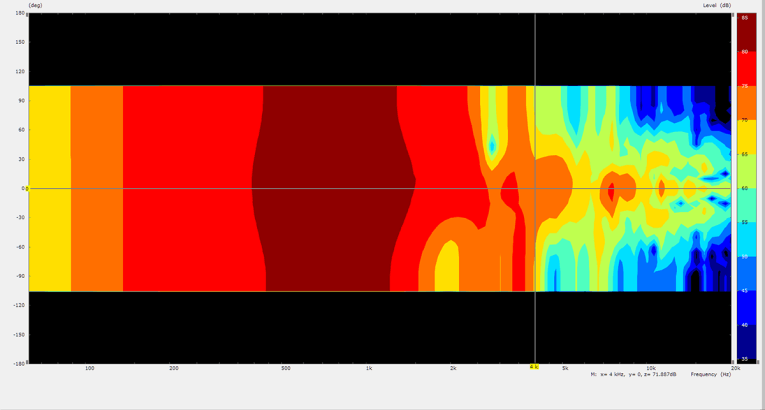
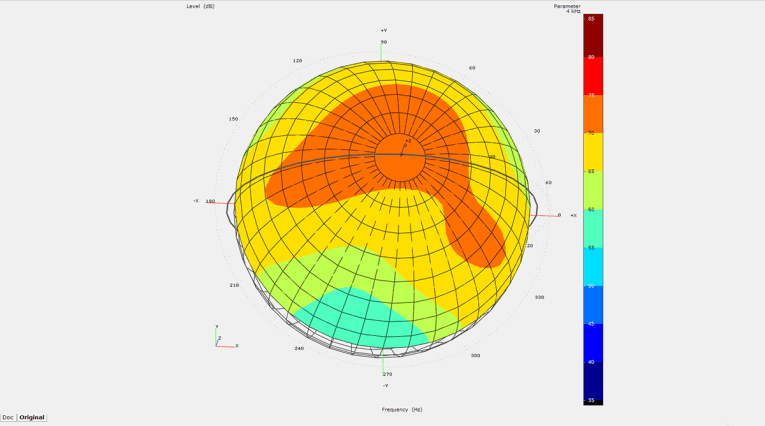
Better Quality, Fewer Prototypes
Modern methods of virtual product development make it possible to assess and optimize quality and performance of consumer and pro audio products throughout the entire product development process.
Acoustical virtual product development enables concept ideas and technical development statuses to be assessed, interpreted, and optimized. Shortcomings and errors, which would become costly in later phases of development and seriously impact scheduling, are detected early. Working in the virtual domain, consumer and professional audio developers and product managers are able to analyze the entire concept, from initial ideas through to the final results.
The experts can safely assess whether the product concept meets the desired requirements. Important development tasks can be carried out using multidisciplinary simulations, and VR applications before prototypes serve as an alternative to production of several physical models. This shortens development times, reduces costs, and improves quality. aX
This article was originally published in audioXpress, September 2020.
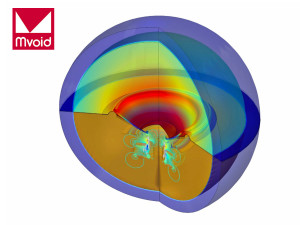 Mvoid — A Partner for Acoustical Virtual Product Development
Mvoid — A Partner for Acoustical Virtual Product DevelopmentThe use of virtual sound systems requires a high degree of know-how in acoustics and multiphysics simulation as well as the combination of advanced tools. Mvoid is a pioneer and expert in virtual acoustics with the focus on simulation of all hardware in the audio chain.
The company guides manufacturers and R&D departments in Acoustical Virtual Product Development, a process that uses advanced multiphysics simulations and combines modeling of all aspects of an audio system, culminating in real-time auralizations that allow actual listening evaluation and validation of design decisions.
Mvoid provides a virtual development environment based purely on computer-generated models and its own VRtool, a virtual tuning and auralization solution where acoustic results can be auditioned over headphones. The VRtool, was fully developed in-house and is one example of Mvoid’s innovations.
The company uses other proprietary modules that integrate with industry standard software packages to realize and implement multidisciplinary simulations. The virtual development environment reduces the need for physical prototypes to an absolute minimum and offers the right solution for every step of the development process. The “virtual acoustical reality” provides more efficiency and promotes innovation in the development of advanced audio systems. The development environment is designed to meet customer requirements at any level and scale.
Mvoid Group | Mvoid Technologies GmbH
Am Wetterbach 2
76228 Karlsruhe
Germany
Phone: +49 721 754076-20
Fax: +49 721 754076-29
Website: www.mvoid-group.com
About the Authors
Dr. Alfred J. Svobodnik is President & CEO of the Mvoid Group. He is an entrepreneur, thought leader, engineer and scientist. He has been researching for 30 years in the areas of Multiphysics and virtual as well as computational acoustics. In 1990 Alfred completed his doctorate at Vienna University of Technology with the degree “Doktor der Techn. Wissenschaften” (equivalent to PhD).
Thomas Gmeiner leads Mvoid's business unit Professional Audio. Thomas has more than 22 years of experience in acoustics, especially in audio engineering, business to technology development, microphones, headphones, digital wireless transmission and loudspeakers. Thomas holds two master’s degrees, one in electrical engineering from University of Technology Graz, Austria, and one in acoustics from Penn State University.




